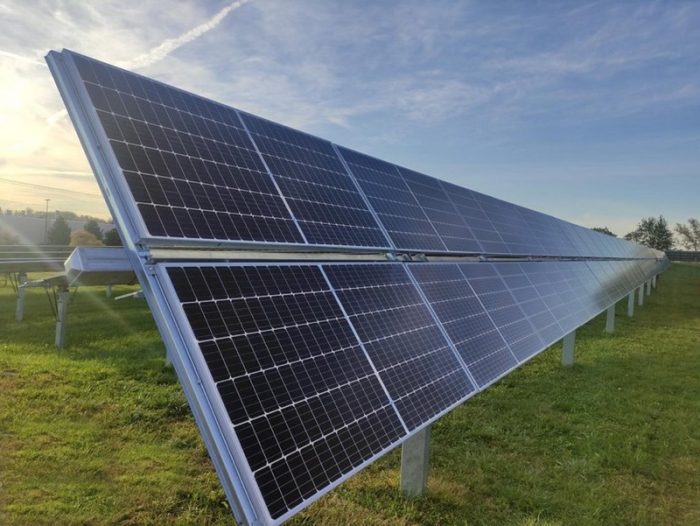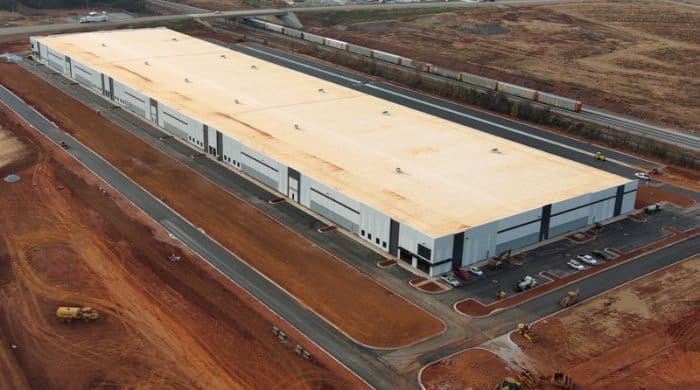
The dawn of the domestic content era has begun in the United States solar industry, and arguably no tracker manufacturer is better positioned to support it than OMCO Solar.
OMCO is a U.S. steel fabrication company. They have been roll forming steel parts for multiple industrial and transportation markets for over 75 years, and in 2007 they formed a wholly-owned subsidiary, OMCO Solar LLC, to focus on contract manufacturing for solar companies.
“We delivered 8 GW worth of products for other racking suppliers, tracker suppliers, and the First Solar designed product,” says Eric Goodwin, director of business development at OMCO Solar, in a conversation at Intersolar North America this year.
“At that point, we knew that we had a lot of expertise. We’d seen a lot of things in the field. We understood some designs that were better than others, and we had a team that had a good level of experience. So, it made sense on a lot of levels for us to start designing our own products.”
In 2017, OMCO Solar officially turned that solar experience into its own factory-direct fixed tilt mounting system – soon to be followed by the OMCO Origin Tracker in 2019.
Since then, OMCO has carved out a big chunk of the distributed generation market with that factory-direct fixed tilt mounting system as well as its tracker – the 1P OMCO Origin tracker debuted in 2019, and a two-in-landscape bifacial version launched in 2021. The next step ahead is supplying more utility-scale-size 100+ MW solar projects. With established suppliers in the market, OMCO Solar is embracing the challenge because utility-scale solar is set to grow exponentially, and so are OMCO’s U.S. manufacturing capabilities.
“For us, it was never about capacity – we’ve got 10 GW of annual capacity across now six facilities,” Goodwin reminds, “but it was about having a product ready to scale. And now we have many projects in the ground, and our trackers are operating with excellent uptime. We still have the strategy to do smaller [distributed generation] projects – and we’ve been doing utility-scale fixed-tilt projects for years – but we’re at a point now where we’re ready to also tackle utility-scale tracker projects.”
Here is the rest of our chat with Goodwin and Matt Kesler, OMCO’s director of solar technology, about the lessons learned in manufacturing and marketing their own branded product for the first time, and the potential advantages of their steel origins and factory-direct model in the domestic content era.

Crowell: When you look back at your start in solar to now – in terms of designing and marketing a system of your own – was it harder than anticipated? Easier? Did you have to pivot in a certain way over time?
Goodwin: “What I personally maybe underestimated is the competitors in the market that had established customers and those relationships. I think the key was we had to get something in the ground, and we had to be creative about showing what our product does. That first project for us was a technical vocational school in Plymouth, Massachusetts, called The Old Colony. We worked with a high school student and put one rack in, donated to the school, and helped them with their training program. We got a lot of nice media out of that. [Editor’s Note: Like a Solar Builder Editor’s Choice Award in 2018.] And then, you know, slowly we started to get some traction.”
Matt Kesler: “We’re a manufacturing company from 75 years ago. We’d like to think that we manufacture trackers in the plant, but we really don’t. You make the components in the plant, but the tracker never exists until it’s assembled in the field. You’re really doing your manufacturing in the field.
“If you know how manufacturing works, how tolerances work, how processes work, how metrics work, then you can take those same things that let you have very high yields and manufacturing in the plant and apply them to making your product in the field. So, you’re both designing for manufacture, and designing so that it can be easily assembled in the field.
“And you’re also teaching the processes. Our installers, after about the first site or two that they’ve done, give us very positive feedback that we’re either the best or among the top trackers to be easily installed. The reason is because it’s designed that way.”
Crowell: What are some of those product design nuances?
Goodwin: “During the time as a contract manufacturer, we saw everything. I’ve been on sites where 200 construction workers are waiting on a guy to come with a box of nuts and bolts. So, we looked at opportunities to do pre-assembly in the factory. With our tracker, our module mount and bearing is basically one unit. Then, we have a lot of adjustability for misaligned piles. We’ve seen that a lot. In short, we don’t have as many parts to put together so, ideally, that makes it a little bit easier.”
Kesler: That’s a huge design philosophy thing for us: Preassembly. We counted the number of fasteners — not the number of fasteners in the tracker, but the number of fasteners that the installer has to touch in the field – and asked how can we minimize the fasteners? How can we make as many of them the same type of fastener? And how can we minimize the number of them that have to be touched in the field and do as much preassembly in the plant as possible?
Crowell: Can you explain the advantages of your steel buying power?
Goodwin: “Other companies are solar manufacturers that buy steel; we’re a steel company and then also a solar company. As a steel company, we buy tons and tons of steel — a couple of million tons a year across multiple markets.”
Kesler: “We will probably ship a quarter of a billion pounds of steel products this year.”
Goodwin: “With that comes relationships with our suppliers, which are some of the larger steel suppliers. We have the ability to negotiate volume rates. We have the ability to, when there’s allocation of steel, to have preference on getting steel. Steel pricing has been pretty volatile since COVID, and we have the ability to get steel at lower than market because of our negotiating power. That allows us to hold product, which is nice because I have yet to see the solar project that starts exactly on the start date.”
Crowell: You also own the largest U.S. manufacturing footprint among tracker companies, with the six plants nationwide. What are the advantages of owning the full manufacturing footprint versus other companies relying on contract suppliers?
Goodwin: “The differentiator is just being able to control everything. We can scale to duplicate lines in different plants. If I’m supplying a tracker project in Texas, or California, or New Mexico, I’m going to make everything in Phoenix, and I’m going to give you the best freight rate. If I’m doing fixed tilt in New York, I’m going to make it all in Ohio and get it there in a day and a half. We make our own foundations as well. We had a case where a project was almost done with the pile install, and a forklift ran over a pallet of piles, and they needed 10 extra files. We were able to put it on the line the next morning, and we had them there within a day and a half. Those are the little things that being factory-direct gives us an advantage.
“The direct-pay incentives in the IRA provide even more benefit. As an example: We make our torque tubes and most everyone else is sourcing those. So, we’re going to see all of [the direct-pay], and can pass the benefit along to our customers, because we’re the OEM.”
Crowell: I was wondering about that – the interplay of the domestic manufacturing benefits in the IRA for the manufacturer and for the buyer. The buyer gets that domestic content tax adder, but maybe the supplier can also offer a better price because of the manufacturing incentives?
Kessler: “For the tracker, the number one big cost in weight is the torque tube, which we make in house. That’s about a third or more of the total. The second, which is about a fourth or more of the total, is the piles, which we make in house. After that, every other structural piece, like the bearings, the steel module mounts, the splices that connect the torque tubes to each other, the pieces that connect all of the above to the post – all of those we make in house.
“At the moment there’s only three parts of that whole tracker that we don’t make in house in the U.S., and over the course of this year, we’re looking at strategies for all of those as well. If there’s somebody that’s going to be able to make an entirely 100% U.S. tracker, we might be able to be the first to do that.”

Crowell: Plus, your partnership with First Solar and the steel backrails you’re producing for their Series 7 modules. That’s quite a combination of tracker and module in terms of domestic content.
Kesler: “The Series 7 module has no frame around it. There are two steel rails on the back, and we’re making those for them. We built a new OMCO plant right by the First Solar plant in Alabama, specifically to make those. So that’s OMCO Solar making the back rails in the U.S., First Solar making the modules, and OMCO making the trackers, all right there within a few miles of each other in Alabama.”
Crowell: Looking ahead, are there any segments or regions that you’re particularly bullish on?
Goodwin: “On the DG side, we’ve seen Illinois kind of blow up. There’s a lot happening in the Midwest. You’re starting to see Indiana, Ohio – we’re doing a lot of fixed tilt in Ohio, about five or six projects, anywhere from five to 10 MWs.
“The Northeast is really busy. I never thought we’d be doing as many tracker projects in states like Maine or New York as we are, which is really cool. There’s still a lot of fixed tilt happening there too. Vermont is starting to kick in. We’ve got our first projects being installed there soon.
“On the utility-scale side, Texas has gotten pretty big, Arizona, California, a lot of stuff happening in Virginia. We probably do more fixed in Florida because of the wind and some of the requirements there.”
— Solar Builder magazine

Leave a Reply
You must be logged in to post a comment.